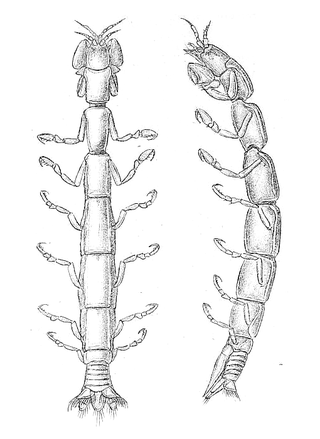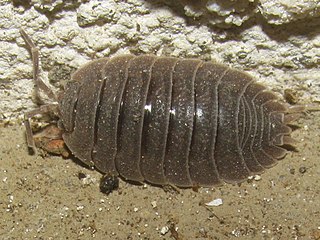
Isopoda is an order of crustaceans. Members of this group are called Isopods and include both terrestrial and aquatic species such as woodlice. All have rigid, segmented exoskeletons, two pairs of antennae, seven pairs of jointed limbs on the thorax, and five pairs of branching appendages on the abdomen that are used in respiration. Females brood their young in a pouch under their thorax.

The Gnathiidae are a family of isopod crustaceans. They occur in a wide range of depths, from the littoral zone to the deep sea. The adults are associated with sponges and may not feed. The juvenile form is known as a 'praniza', and it is a temporary parasite of marine fish. These forms are not larvae; Gnathiidae instead become parasitic during the manca stage. Mancae of the Gnathiidae closely resemble the adult form, however they lack the final pair of pereiopods.

The Valvifera are marine isopod crustaceans. Valviferans are distinguished, however, by the flat, valve-like uropods which hinge laterally and fold inward beneath the rear part of their bodies, covering the pleopods. Some species are omnivorous, and serve as effective scavengers in the economy of the sea.

Sphaeromatidae is a family of isopods, often encountered on rocky shores and in shelf waters in temperate zones. The family includes almost 100 genera and 619 known marine species. Within these genera, there are groups that share distinctive morphologies; further research may reclassify these genus-groups as separate families.

Anthuroidea is a superfamily of isopod crustaceans, formerly treated as a suborder, Anthuridea. The group is characterised by "an elongate cylindrical body form, without dorsal coxal plates, and with a uropodal exopod attached to the peduncle proximally and dorsally". There are more than 500 described species in 57 genera, arranged across six families:

The Asellidae are a family of isopod crustaceans, one of the largest families of freshwater isopods, living in both epigean and hypogean habitats in North America and Europe.

The Idoteidae are a family of isopod crustaceans. It includes these genera:

Cymothoida is the name of a suborder of isopod crustaceans with a mostly carnivorous or parasitic lifestyle. It contains more than 2,700 described species in four superfamilies. Members of the suborder are characterised by their specialised mouthparts which include a mandible with a tooth-like process which is adapted for cutting or slicing.
Phoratopus remex is a species of isopod crustaceans known from only two specimens, and first described in 1925 by Herbert Matthew Hale (1895–1963). It lives on the continental shelf at Encounter Bay and Fowlers Bay, South Australia. It is so unlike all other isopods that it is placed in its own family, Phoratopodidae and suborder, Phoratopidea.

Gnorimosphaeroma is a genus of isopod crustaceans, containing the following species:

Asellus is a genus of isopod crustaceans in the family Asellidae.

Saduria is a genus of benthic isopod crustaceans in the family Chaetiliidae, containing the following species:
Ligia natalensis is a woodlouse-like isopod in the family Ligiidae.

Ligia dilatata is a woodlouse in the family Ligiidae.

Dynoides elegans is a species of isopod crustacean in the genus Dynoides. It was originally described in 1923 by Pearl Lee Boone as "Cianella elegans" based on specimens from La Jolla and San Pedro, California. It was transferred to the genus Dynoides in 2000, when Boone's genus was sunk into synonymy with Dynoides.

Porcellio dilatatus is a species of woodlouse in the genus Porcellio belonging to the family Porcellionidae. This species is widespread in Europe, and has also been introduced to North America from Western Europe. They are 15 millimetres (0.59 in) long, are brown coloured and striped. They can be found feeding on alder leaves, but mostly feeds on organic food substrates, such as lettuce in the wild. It also feeds on inorganic metal salts.

Uromunna is a genus of isopod crustaceans.

Armadillidae is a family of woodlice, comprising around 80 genera and 700 species. It is the largest family of Oniscidea, and one of the most species-rich families of the entire Isopoda. Most of the armadillidae taxa are not monophyletic. Armadillids generally have a strongly convex body shape, with some rather shallowly convex. Like members of the woodlice family Armadillidiidae, armadillids are capable of enrolling into a sphere (conglobation), and are commonly known as pill bugs. Some species, however, have secondarily lost their conglobation ability. For example, a species exist in which the males lack the inner face of the coxal plates and are therefore unable to conglobate. Armadillids differ from the Armadillidiidae in that the antennae are fully enclosed within the sphere.

Euidotea durvillei, known commonly as the red seaweed isopod, is a species of marine isopod found in New Zealand.
Nataldillo is a genus of isopods belonging to the family Armadillidae.














